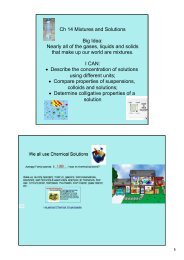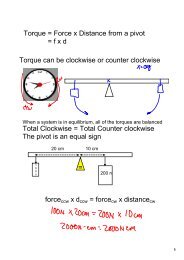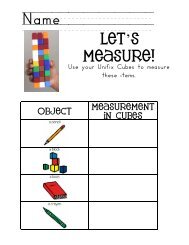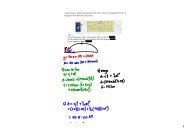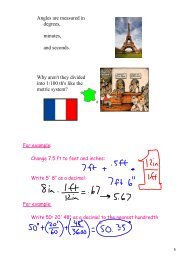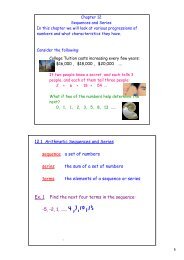Mechanical Waves Mechanical Wave
Mechanical Waves Mechanical Wave
Mechanical Waves Mechanical Wave
Create successful ePaper yourself
Turn your PDF publications into a flip-book with our unique Google optimized e-Paper software.
CH 17 - MECHANICAL WAVES & SOUND<br />
Sec. 17.2 - <strong>Mechanical</strong> <strong><strong>Wave</strong>s</strong><br />
<strong>Mechanical</strong> <strong>Wave</strong> - disturbance in matter that carries energy<br />
from one place to another.<br />
• <strong>Mechanical</strong> waves require matter called a MEDIUM to travel<br />
through<br />
• A medium can be solid, liquid or gas<br />
• A mechanical wave is created when a source of energy causes a<br />
vibration to travel through a medium.<br />
1
3 TYPES OF MECHANICAL WAVES:<br />
1) TRANSVERSE - a wave that causes the medium to vibrate at<br />
right angles (perpendicular) to the direction in which the wave<br />
travels.<br />
o<br />
o<br />
o<br />
Shaking a rope up and down<br />
Crest = highest point from rest position<br />
Trough = lowest point below rest position<br />
http://www.phy.hk/wiki/englishhtm/TwaveA.htm<br />
2
2) LONGITUDINAL WAVE- a wave in which the vibration of the<br />
medium is PARALLEL to the direction the wave travels; sound<br />
waves are this type<br />
• Created by pushing and pulling in one direction<br />
• Compression = area where particles are spaced close<br />
together<br />
• Rarefaction = area where particles are spread out<br />
http://en.wikipedia.org/wiki/File:Longitudinalwave.ogg<br />
• http://www.acoustics.salford.ac.uk/feschools/waves/wavetypes.htm<br />
P waves ( primary waves ) caused by earthquakes<br />
3
3) SURFACE WAVE- a wave that travels along a surface<br />
separating two media.<br />
• Ocean waves<br />
• Combination of transverse and longitudinal causes a bobber<br />
on the surface to move in a circle in deep water<br />
• When ocean waves enter shore they topple over themselves<br />
because friction with the shore slows down the bottom of the<br />
wave.<br />
5
Sec. 17.2 - PROPERTIES OF MECHANICAL WAVES<br />
Periodic motion - any motion that repeats at regular intervals<br />
Period - the time required for one cycle (time between 2<br />
successive crests or compressions)<br />
Frequency - the number of complete wave cycles in a given time<br />
(cycles per second = hertz (Hz)<br />
Frequency = frequency of the vibration source producing the<br />
wave<br />
6
<strong>Wave</strong>length- the distance between a point on one wave and the<br />
same point on the next cycle of the wave (crest to crest or<br />
compression to compression.)<br />
Increasing the frequency of a wave decreases<br />
wavelength.<br />
its<br />
7
Amplitude - maximum displacement of the medium from its rest<br />
position (height of wave)<br />
o The more energy a wave has the greater its amplitude!<br />
o In longitudinal waves the amplitude is the maximum<br />
displacement of a point from its rest position<br />
8
Speed of wave = wavelength x frequency<br />
V = λ f<br />
Speed = wavelength x frequency<br />
The speed of a wave can change if it enters a new medium or if<br />
pressure and temperature change.<br />
If not told otherwise, assume waves are traveling at a constant<br />
speed. Therefore, wavelength is inversely proportional to<br />
frequency.<br />
9
Try these:<br />
1) The waves in a pool have a wavelength of 0.20 m and a<br />
frequency of 2.8 Hz. What is the speed of these waves<br />
10
2) A student moves the end of a soft spring back and forth to<br />
make waves. The waves travel at 1.8 m/s and have a wavelength of<br />
1.2 m. What is the frequency of these waves<br />
11
Sec. 17.3 - BEHAVIOR OF WAVES<br />
1) REFLECTION - occurs when a wave bounces off a surface that<br />
it cannot pass through.<br />
Reflection does not change the speed or frequency of a wave,<br />
but the wave can be flipped upside down if the reflection occurs at<br />
a fixed boundary.<br />
12
2) REFRACTION- the BENDING of a wave as it enters a new<br />
medium at an angle; occurs because one side of the wave moves<br />
more slowly than the other side.<br />
If ocean wave fronts approach the shore at an angle they will<br />
refract because one side of the wave moves more slowly than the<br />
other side.<br />
13
3) DIFFRACTION - Bending of a wave as it moves around an<br />
obstacle or passes through a narrow opening. A wave diffracts<br />
more if its wavelength is large compared to the size of an opening<br />
or obstacle<br />
14
4) INTERFERENCE - Occurs when two or more waves OVERLAP and<br />
combine together<br />
1. CONSTRUCTIVE INTERFERENCE - When two or more waves<br />
combine to produce a wave with a larger displacement (amplitude.)<br />
2. DESTRUCTIVE INTERFERENCE - When two or more waves<br />
combine to produce a wave with smaller displacements (amplitude.)<br />
http://id.mind.net/~zona/mstm/physics/waves/interference/intrfrnc.html<br />
15
Chromatic interference is seen in sea foam, which is made out of Plankton. It is an example of<br />
the naturally occurring interference.<br />
http://en.wikipedia.org/wiki/File:Two_sources_interference.gif<br />
http://www.acoustics.salford.ac.uk/feschools/waves/super2.htm<br />
16
STANDING WAVES - A wave that appears to stay in one place, not<br />
travel through the medium<br />
v When a wave is created and its reflected wave interferes with it<br />
“perfectly.”<br />
v Plucking a guitar string produces a standing wave<br />
v NODE - point on standing wave that has NO displacement (no<br />
movement) from resting position due to complete destructive<br />
interference.<br />
18
v ANTINODE - point on standing wave were a crest or a trough<br />
occurs midway between two nodes. Maximum displacement due to<br />
complete constructive interference.<br />
A standing wave forms ONLY if half of a wavelength or a multiple<br />
of half a wavelength fits EXACTLY into the length of a vibrating<br />
cord.<br />
19
How many wavelengths does this standing wave have<br />
How many nodes antinodes<br />
20
Sec. 17.4 - Sound & Hearing<br />
Sounds waves --> longitudinal waves that travel through a medium<br />
Properties of sound waves:<br />
1) Speed --> 342 m/s in dry, 20 o C air; speed varies depending on<br />
the medium.<br />
Sound waves tend to travel fastest in solids, slower in liquids and<br />
slowest in gases because the distance between particles is<br />
greatest in gases. Both density and elasticity of the particles<br />
affect speed.<br />
21
2) Intensity --> rate at which a wave‛s energy flows through a<br />
given area; depends on both the wave‛s amplitude & distance from<br />
the sound source.<br />
Intensity is measured in decibels. For every 10<br />
decibel increase, the intensity increases tenfold<br />
Sound<br />
Intensity level(decibels)<br />
Human Hearing threshold 0<br />
Whisper 1520<br />
Normal conversation 4050<br />
Street noise 6070<br />
Inside a bus 90100<br />
Operating heavy machinery 80120<br />
Rock concert 110120<br />
Threshold of pain 120<br />
Jet plane taking off 120160<br />
22
3) Loudness --> physical response to the intensity of sound; is<br />
subjective as it depends on ear health and brain interpretation<br />
4) Pitch --> how the frequency of sound is perceived; remember<br />
that frequency is how fast the wave is vibrating.<br />
High pitch sounds have a high frequency.<br />
Low pitch sounds have a low frequency.<br />
Humans typically hear between 20-20,000 hertz.<br />
Ultrasound --> frequencies greater than 20,000 hertz; beyond<br />
range of human hearing.<br />
Sonar = SOund NAvigation & Ranging; uses the<br />
speed of sound in water and the time that the<br />
sound takes to reach an object and the bounce<br />
back from the object (echo); also called<br />
echolocation; uses ultrasound frequencies.<br />
23
Ex: A submarine uses SONAR to measure the distance to the bottom of the<br />
ocean. If an ultrasound signal is sent and it takes 7 seconds to receive the echo,<br />
how far away is the bottom of the ocean (speed of sound in water = 1546 m/s)<br />
speed = distance x time<br />
1546 m/s = (d)(7 s.)<br />
d = 271 m. / 2 (because its an echo)<br />
so: d = 136 m. to the bottom<br />
24
Doppler Effect --> a change in sound frequency caused by motion<br />
of the sound source, motion of the listener, or both.<br />
As a source of sound approaches, an observer<br />
hears a higher frequency. When the sound<br />
moves away, the observer hears a lower<br />
freqency.<br />
Observer B will hear a higher pitch because the waves are<br />
bunched together while Observer A will have a lower pitch because<br />
the waves are spread apart.<br />
25
The Human Ear --> the outer ear gathers and focuses sound into<br />
the middle ear; the middle ear receives and amplifies the<br />
vibrations; the inner ear uses nerve endings to sense vibrations<br />
and send signals to the brain.<br />
26
How human hearing works:<br />
1) The pinna (outer sound-collecting part) funnels sound waves down<br />
the ear canal.<br />
2) The ear canal (about 2.5 cm. long) carries the sound waves to the<br />
tympanic membrane.<br />
3) The tympanic membrane (a tightly stretched membrane) vibrates<br />
at the same frequency as the sound waves striking it.<br />
4) The tympanic membrane is touching the malleus (hammer) which<br />
then begins to vibrate. The malleus strikes the incus (anvil) which<br />
then begins to vibrate.<br />
The incus then strikes the stapes (stirrup) which is set into motion.<br />
5) These bones act to amplify the motion of the eardrum.<br />
6) The stirrup is in contact with the cochlea, a spiral-shaped canal<br />
filled with fluid. The inside of the cochlea is lined with thousands of<br />
nerve cells with tiny hair-like projections. As the projections sway<br />
back and forth, they send electrical impulses to the brain.<br />
28
How sound is reproduced:<br />
1) Sound is recorded by converting sound waves into electronic signals<br />
that can be processed and stored.<br />
2) Sound is then reproduced by converting these electronic signals<br />
back into sound waves.<br />
No matter how sound is stored, it must be converted back into sound<br />
waves by speakers. In a speaker, an electronic signal causes a magnet<br />
to vibrate. The magnet is attached to a membrane. The membrane<br />
vibrates and sends sound wavelengths through the air.<br />
29
Large-diameter speakers are better at reproducing lower frequencies<br />
of sound. Smaller-diameter speakers are better at reproducing higher<br />
frequencies of sound.<br />
Singing into a microphone does the opposite - sound waves vibrate a<br />
membrane inside the microphone, the membrane causes a magnet to<br />
vibrate which produces an electronic signal in the microphone wires.<br />
This electronic signal can then be processed and stored.<br />
30
Music --> most musical instruments vary pitch by changing the<br />
frequency of standing waves.<br />
Resonance --> the response of a standing wave to another wave of<br />
the same frequency; can be used to amplify sound; is a form of<br />
constructive interference; pianos use the sound board to create<br />
resonance and increase the amplitude<br />
Acoustics --> study of sound transmissions; very<br />
important in designing concert halls to prevent<br />
“dead spots” where sound waves can be cancelled<br />
out by destructive interference.<br />
31




